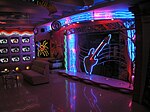Karaoke box

A karaoke box (カラオケボックス, karaoke bokkusu) is a type of karaoke establishment commonly found in East Asia, Southeast Asia, South Asia, the United States and Canada. It originated in Japan, and is now popular worldwide, particularly in Asia.[1] Karaoke boxes consist of multiple rooms containing karaoke equipment, usually rented out for a period of time. A typical karaoke box establishment contains 10–20 (or more) such rooms, that can be themed[2] so that each room has a different feeling or can be a traditional karaoke box, as well as have a main karaoke bar area in the front. Karaoke box establishments often sell beverages, and sometimes food but sometimes the establishment offers free refreshments. Many people of all ages enjoy karaoke as a pastime in Japan, as it still has a huge influence in the Japanese music scene[3] and it is also a place that can attract tourists as well.[4] One blogger, who is a fan of karaoke, writes "...to sing karaoke is to embrace the moment that your love of song transcends your love of self."[5] While people do go to and enjoy karaoke boxes with family and friends, people also go by themselves and are able to enjoy the comfort of performing in the room by themselves.[6] There is also a different style of karaoke, the traditional type where the patrons sing in front of everyone that is also still offered in popular entertainment areas, rather than the private boxes.
A new trend of karaoke booth have shown up in Chinese shopping malls where customers can enter a booth, similar to a photo-booth, that allows them to perform different songs.[7] The booths are cheaper than the traditional karaoke box, as they do not have to rent a room but just go in and sing a number of songs. The booths are very similar to the karaoke boxes but on a more intimate scale, with at least 20,000 booths running with an estimated CN¥3.18 billion (US$477 million) in 2017.[8] The booths have an air conditioner, seats for the customers, the karaoke equipment, and headsets.
Another trend that has popped up recently is offering boxes for daytime meetings for business who need a cheap business room.[9]
There has also been conversation about fire safety with karaoke boxes after an arson in Hong Kong which led to public concern about their safety. One test recreated an establishment with 3 boxes and a corridor, in a remote location in China with the intention of testing a real-time fire in a karaoke establishment.[10] There has also been additional research about karaoke boxes as to ensure the safety of the customers in evacuation research about widening the length of hallways.[11]
The term karaoke box is primarily used in Japan, Hong Kong and Macau. Karaoke box establishments are commonly known as KTV (an abbreviation of karaoke television) in Taiwan, China, Cambodia, Myanmar, Singapore, the United States and Canada, videoke in the Philippines, noraebang (노래방) in South Korea (literally meaning singing room), hwamyŏn panju ŭmaksil (화면반주음악실) in North Korea, karaoke room in Vietnam, and karaoke club in Sri Lanka.[12] It is also common to simply abbreviate it as K in Hong Kong Cantonese, often when used as a verb, for example 去K歌 (to go K songs) or 去唱K (to go sing K).
Gallery[edit]
-
Lobby of a karaoke box in Japan
-
Entrance to a karaoke box in Harbin, China
-
Entrance to the Best Western Hotel Apollo and Karaoke Bar in Oulu, Finland
-
A karaoke box in a skyscraper in Shinjuku, Tokyo, featured in the movie Lost in Translation.
Legal issues[edit]
KTV can also refer to a karaoke music video, a music video with karaoke lyrics and MMO audio track. Some karaoke music videos were sold to KTV establishments under exclusivity contracts, making some people use them to copy karaoke music videos illegally and share them on the Internet. These are often found on the Internet in MPEG (VCD) or VOB (DVD) format with (KTV) appended to the filename.
References[edit]
- ^ Fung, Anthony (2009-12-01). "Consuming Karaoke in China". Chinese Sociology & Anthropology. 42 (2): 39–55. doi:10.2753/CSA0009-4625420202. ISSN 0009-4625. S2CID 143804901.
- ^ Box, August Karaoke. "KARAOKE In A WHOLE NEW LEVEL". August Karaoke Box. Retrieved 2020-03-02.
- ^ Ogawa, Hiroshi (2005-06-20). "The effects of karaoke on music in Japan". Karaoke Around the World. Routledge. doi:10.4324/9780203982396. ISBN 9780203982396. Retrieved 2020-04-03.
- ^ "Karaoke". www.japan-guide.com. Retrieved 2020-04-03.
- ^ Smith, Rich. "In Defense of Karaoke". The Stranger. Retrieved 2020-04-03.
- ^ Armitage, Susie (2018-08-03). "Tokyo's Best Karaoke Is Karaoke Sung Alone". The Daily Beast. Retrieved 2020-04-03.
- ^ Li, Eva (2 August 2017). "China's Newest Trend: mini karaoke booths at shopping malls". South China Morning Post. Retrieved 2020-03-02.
- ^ "China's newest trend: mini KTV booths at shopping malls". South China Morning Post. 2017-08-02. Retrieved 2020-03-02.
- ^ Hongo, Jun (2016-04-11). "Japan's Karaoke Rooms Stop the Music for Business Meetings". Wall Street Journal. ISSN 0099-9660. Retrieved 2020-04-03.
- ^ Chow, Wan Ki; Leung, CW; Zou, G; Dong, H.; Gao, YE (2003). "Assessment of Fire Hazard in Timber Karaoke Music Boxes With Real-Scale Burning Tests". Journal of Applied Fire Science. 12 (2): 107–124. doi:10.2190/EQRN-DJWD-8CYD-FLNR. ISSN 1044-4300.
- ^ Chow, W. K.; Lui, Gigi C. H. (2002-03-01). "Numerical studies on evacuation design in a karaoke". Building and Environment. 37 (3): 285–294. Bibcode:2002BuEnv..37..285C. doi:10.1016/S0360-1323(01)00022-1. ISSN 0360-1323.
- ^ "Untitled Document". www.sundaytimes.lk.
External links[edit]
- At the Mic: Karaoke Television, by Mia Dick, Compass Magazine, April–May 1998, retrieved 5 November 2006.
- Karaoke Players Info: More about the usage of karaoke around the world.
- Karaoke
- Japanese popular culture
- Culture of Cambodia
- Chinese culture
- Cantonese culture
- Culture of Hong Kong
- Culture of Macau
- Culture of Singapore
- Culture of Malaysia
- Culture of Indonesia
- Philippine popular culture
- South Korean popular culture
- Culture of Sri Lanka
- Culture of Taiwan
- Culture of Thailand
- Culture of Vietnam




